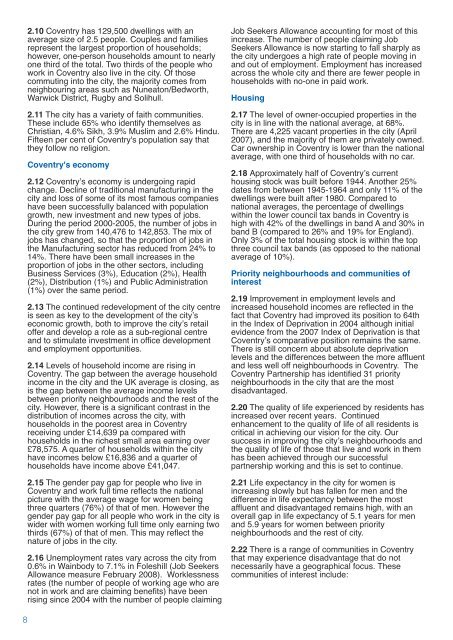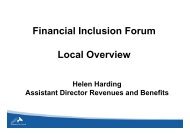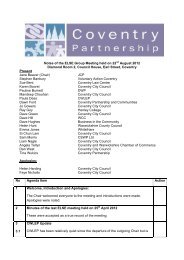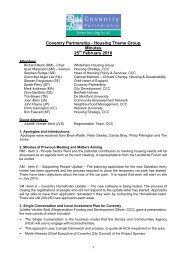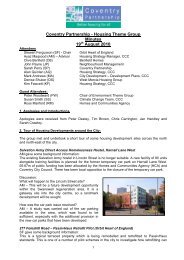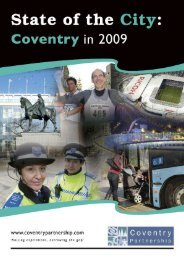Sustainable Community Strategy - Coventry Partnership
Sustainable Community Strategy - Coventry Partnership
Sustainable Community Strategy - Coventry Partnership
Create successful ePaper yourself
Turn your PDF publications into a flip-book with our unique Google optimized e-Paper software.
2.10 <strong>Coventry</strong> has 129,500 dwellings with an<br />
average size of 2.5 people. Couples and families<br />
represent the largest proportion of households;<br />
however, one-person households amount to nearly<br />
one third of the total. Two thirds of the people who<br />
work in <strong>Coventry</strong> also live in the city. Of those<br />
commuting into the city, the majority comes from<br />
neighbouring areas such as Nuneaton/Bedworth,<br />
Warwick District, Rugby and Solihull.<br />
2.11 The city has a variety of faith communities.<br />
These include 65% who identify themselves as<br />
Christian, 4.6% Sikh, 3.9% Muslim and 2.6% Hindu.<br />
Fifteen per cent of <strong>Coventry</strong>'s population say that<br />
they follow no religion.<br />
<strong>Coventry</strong>'s economy<br />
2.12 <strong>Coventry</strong>ʼs economy is undergoing rapid<br />
change. Decline of traditional manufacturing in the<br />
city and loss of some of its most famous companies<br />
have been successfully balanced with population<br />
growth, new investment and new types of jobs.<br />
During the period 2000-2005, the number of jobs in<br />
the city grew from 140,476 to 142,853. The mix of<br />
jobs has changed, so that the proportion of jobs in<br />
the Manufacturing sector has reduced from 24% to<br />
14%. There have been small increases in the<br />
proportion of jobs in the other sectors, including<br />
Business Services (3%), Education (2%), Health<br />
(2%), Distribution (1%) and Public Administration<br />
(1%) over the same period.<br />
2.13 The continued redevelopment of the city centre<br />
is seen as key to the development of the cityʼs<br />
economic growth, both to improve the cityʼs retail<br />
offer and develop a role as a sub-regional centre<br />
and to stimulate investment in office development<br />
and employment opportunities.<br />
2.14 Levels of household income are rising in<br />
<strong>Coventry</strong>. The gap between the average household<br />
income in the city and the UK average is closing, as<br />
is the gap between the average income levels<br />
between priority neighbourhoods and the rest of the<br />
city. However, there is a significant contrast in the<br />
distribution of incomes across the city, with<br />
households in the poorest area in <strong>Coventry</strong><br />
receiving under £14,639 pa compared with<br />
households in the richest small area earning over<br />
£78,575. A quarter of households within the city<br />
have incomes below £16,836 and a quarter of<br />
households have income above £41,047.<br />
2.15 The gender pay gap for people who live in<br />
<strong>Coventry</strong> and work full time reflects the national<br />
picture with the average wage for women being<br />
three quarters (76%) of that of men. However the<br />
gender pay gap for all people who work in the city is<br />
wider with women working full time only earning two<br />
thirds (67%) of that of men. This may reflect the<br />
nature of jobs in the city.<br />
2.16 Unemployment rates vary across the city from<br />
0.6% in Wainbody to 7.1% in Foleshill (Job Seekers<br />
Allowance measure February 2008). Worklessness<br />
rates (the number of people of working age who are<br />
not in work and are claiming benefits) have been<br />
rising since 2004 with the number of people claiming<br />
Job Seekers Allowance accounting for most of this<br />
increase. The number of people claiming Job<br />
Seekers Allowance is now starting to fall sharply as<br />
the city undergoes a high rate of people moving in<br />
and out of employment. Employment has increased<br />
across the whole city and there are fewer people in<br />
households with no-one in paid work.<br />
Housing<br />
2.17 The level of owner-occupied properties in the<br />
city is in line with the national average, at 68%.<br />
There are 4,225 vacant properties in the city (April<br />
2007), and the majority of them are privately owned.<br />
Car ownership in <strong>Coventry</strong> is lower than the national<br />
average, with one third of households with no car.<br />
2.18 Approximately half of <strong>Coventry</strong>ʼs current<br />
housing stock was built before 1944. Another 25%<br />
dates from between 1945-1964 and only 11% of the<br />
dwellings were built after 1980. Compared to<br />
national averages, the percentage of dwellings<br />
within the lower council tax bands in <strong>Coventry</strong> is<br />
high with 42% of the dwellings in band A and 30% in<br />
band B (compared to 26% and 19% for England).<br />
Only 3% of the total housing stock is within the top<br />
three council tax bands (as opposed to the national<br />
average of 10%).<br />
Priority neighbourhoods and communities of<br />
interest<br />
2.19 Improvement in employment levels and<br />
increased household incomes are reflected in the<br />
fact that <strong>Coventry</strong> had improved its position to 64th<br />
in the Index of Deprivation in 2004 although initial<br />
evidence from the 2007 Index of Deprivation is that<br />
<strong>Coventry</strong>ʼs comparative position remains the same.<br />
There is still concern about absolute deprivation<br />
levels and the differences between the more affluent<br />
and less well off neighbourhoods in <strong>Coventry</strong>. The<br />
<strong>Coventry</strong> <strong>Partnership</strong> has identified 31 priority<br />
neighbourhoods in the city that are the most<br />
disadvantaged.<br />
2.20 The quality of life experienced by residents has<br />
increased over recent years. Continued<br />
enhancement to the quality of life of all residents is<br />
critical in achieving our vision for the city. Our<br />
success in improving the cityʼs neighbourhoods and<br />
the quality of life of those that live and work in them<br />
has been achieved through our successful<br />
partnership working and this is set to continue.<br />
2.21 Life expectancy in the city for women is<br />
increasing slowly but has fallen for men and the<br />
difference in life expectancy between the most<br />
affluent and disadvantaged remains high, with an<br />
overall gap in life expectancy of 5.1 years for men<br />
and 5.9 years for women between priority<br />
neighbourhoods and the rest of city.<br />
2.22 There is a range of communities in <strong>Coventry</strong><br />
that may experience disadvantage that do not<br />
necessarily have a geographical focus. These<br />
communities of interest include:<br />
8


